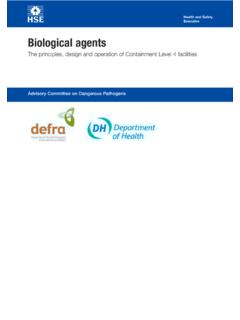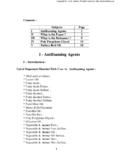Transcription of Guidance on the use, testing and maintenance of laboratory ...
1 Guidance on the use , testing and maintenance of laboratory and animal isolators for the containment of biological agents 1. Introduction 1. This Guidance gives advice on factors to consider when selecting, using, testing and maintaining negative pressure isolators for experiments involving biological agentsa and replaces previous Guidance issued in 19851. The main scenarios covered by this Guidance are laboratory isolators for housing equipment/large experiments etc and animal husbandry isolators for animals infected with biological agents. Pharmaceutical isolators, particularly those operated at positive pressures are covered by separate publications2. 2. It is aimed at employers, laboratory managers, safety advisors and users. Other groups such as manufacturers and companies which offer testing and maintenance services may also find it useful. 3. It applies in situations where isolators are selected as the mechanism of primary containment, usually because the task is unsuitable to carry out in a microbiological safety cabinet.
2 It does not cover other laboratory or animal containment strategies such as individually ventilated cages (IVCs) or downdraft tables. The main reason for this is current limited knowledge on the effectiveness of these alternatives for adequately containing aerosols of biological agents, and the range and complexity of testing required to validate this containment. This is not to say that these alternatives cannot be used for work with biological agents, but that it will fall to dutyholders to undertake the relevant testing and monitoring to demonstrate ongoing containment. Given that the use of IVCs is expanding in this area, it is likely that more data will become available to hopefully enable supplementary Guidance to be made available in the future. 2. Legal requirements Health & Safety Issues biological Agents 4. The Control of Substances Hazardous to Health Regulations 2002 (as amended)3 (COSHH).
3 Require employers to prevent, or if this is not reasonably practicable, adequately control exposure of employees to biological agents using measures other than personal protective equipment. Where exposure cannot be prevented employers must take steps to ensure that exposure is adequately controlled by using a combination of control measures specified in Schedule 3 of which states that infected material, including any animal is to be handled in a safety cabinet or isolator or other suitable containment. 5. The Genetically Modified Organisms (Contained Use) Regulations 20004 (as amended) require suitable containment and control measures be used to adequately control against exposure to biological agents which are genetically modified and the Genetically Modified Organisms (Contained Use) (Amendment) Regulations 2005 specifically state that work with infected animals at containment levels 3 and 4 must be undertaken in isolators.
4 6. For small scale in vitro laboratory activities a microbiological safety cabinet (MSC) is widely recognised as offering a practicable engineering solution for controlling aerosols. However for non- standard laboratory activities (such as those involving large pieces of equipment) or animals infected with biological agents, it may not be practicable to use an MSC. 7. Isolators that are used, tested and maintained appropriately are recognised as being able to provide effective engineering control against aerosols from biological agents associated with such activities. However, fundamental to the whole process is a robust risk assessment addressing the specifics of the activities to be undertaken and taking into account relevant Guidance , for example working safely with research animals5. Other Health & Safety issues a A biological agent is defined in COSHH as: a microorganism, cell culture or human endoparasite, whether or not genetically modified, which may cause infection, allergy, toxicity or otherwise create a hazard to human health'.
5 -2- 8. Whilst the primary use of isolators is to control exposure of operators to aerosols of biological agents, it is important to take into account other health and safety issues, including human factors such as ergonomic considerations, in the risk assessments. Further information on this subject can be found in Annex A. Animal Welfare Issues 9. Animal welfare requirements are specified by the Animals (Scientific Procedures) Act 1986. The associated Home Office Code of Practice6 specifies, amongst other things, the minimum environmental parameters that must be met in relation to space, noise, temperature and humidity etc for different animal species. Environmental Issues 10. The GMO Contained Use Regulations require that appropriate measures be in place to protect the environment as well as human health. In addition, the Specified Animal Pathogen Order 19987.
6 Requires the containment of exotic animal pathogens so that the environment is protected. Isolators may be a useful form of primary containment to reduce the likelihood of an environmental pathogen escaping. 3. Types of isolators 11. During selection of an isolator consideration of the main task(s) to be carried out along with related activities (for example, the movement of samples, removal of waste etc) is essential. Further information regarding isolator selection can be found in Annex B. Flexible Film Isolators 12. Flexible Film Isolators (FFIs) are tented enclosures of flexible plastic built on a metal frame. They are routinely accessed from the side through gauntlets or sleeves with cuffed gloves. Ports allow material to both enter and exit the isolator. 13. The size of these units and therefore the amount of equipment within is limited by the degree of access afforded by the gauntlets.
7 Flexible Film Isolators (photo Copyright Health Protection Agency). -3- Rigid Isolators 14. These are essentially the same as FFI's except their canopies are made of a rigid material. Flexible half-suit isolators 15. These are larger than FFIs and are accessed by the operator by half suit(s) in the base of the isolator and also by gauntlets/sleeves and gloves on the side. Operators enter the half suit by ducking under the base and then standing up within the positively pressurised suit. 16. This combination gives the potential for large work surfaces within the isolator due to the increase in accessibility. Flexible half-suit isolators (photo Copyright Health Protection Agency). Flexible half-suit isolators (photo Copyright Health Protection Agency). -4- Rigid half-suit isolators 17. These are essentially the same as flexible half suits isolators except their canopies are made of a rigid material.
8 This makes them more resistant to damage, but less able to absorb pressure fluctuations, for example when entering or exiting the half suits. Rigid half-suit isolators Transfer isolators 18. These are FFIs or rigid isolators used specifically for transferring materials from one isolator/MSC. to another. They are usually battery powered and have docking ports to enable attachment and transfer. Transfer isolators (photo Copyright Health Protection Agency). -5- 4. Commissioning tests for isolators 19. Whilst MSCs have a defined British Standard8, isolators currently have no such equivalent (although general Guidance is given in Annex A of the laboratory Operations Standard9). From a containment perspective there are many similarities between an isolator and a Class III MSCs and wherever possible, isolators should aim to provide a similar level of protection as afforded by the MSC.
9 Following the testing and maintenance regimes in this document will usually ensure that the expected requirements are met. 20. Commissioning of an isolator should be when it is in its final position within the laboratory /animal room. Factory commissioning only is not acceptable. Commissioning will also be required after any major changes to the isolator such as following dismantling and/or movement and additions/alterations. 21. The following 5 tests are considered essential at commissioning: air leaktightness leak detection filters negative pressure air change rates Air Leaktightness 22. The isolator should be leak-tight in order to control exposure to aerosols of biological agents and also gaseous agents ( formaldehyde) used in the disinfection or task process. The MSC British Standard requires a positive pressure hold test be undertaken to determine the air leaktightness of a Class III MSC.
10 The specified overpressure of 500 Pa is unlikely to be practicable in an isolator, particularly film isolators. Instead a practicable alternative could be considered to be a minimum overpressure of 150 Pa. If it was not practicable to overpressure to 150Pa then an appropriate level as determined by risk assessment and advice from the supplier/manufacturer should be used. 23. A suitable pass criteria would be no more than a 10% loss of pressure when the internal isolator pressure is raised to 150Pa and held for 30 minutes. One way of assessing this is described in the information box. Information Box One method for undertaking positive pressure hold test: the isolator should be assembled with all connections (gloves, gauntlets, half suits etc) made. The extract air duct should be blanked off and the internal pressure raised to 150 Pa by the supply air, which should then be blanked off.













